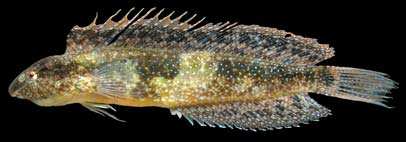| BLENNIIDAE |

Petroscirtes variabilis, 10.6 cm SL
(photo by Seishi Kimura)
|
Petroscirtes variabilis (Peters, 1855) Cloister Blenny |
|
D X-XI, 16-19; A II, 16-19; P1 13-15. Body slender; head moderately pointed; posterior nostril usually with a short flap on anterior rim; cirrus on chin unbranched; other cirri on head variably present or absent; caudal fin slightly rounded with no prolonged rays. Color: variable, but often olive to green dorsally, shading to greenish yellow ventrally, densely mottled and spotted with whitish and dark olive; six large irregular dark blotches usually evident along upper side; some small blue spots sometimes visible posteriorly; dorsal and anal fins with dark spots. Size: maximum length about 13 cm. Distribution: western Pacific to Sri Lanka; north to southern Taiwan and the Yaeyama Islands (Japan), south to the southern Great Barrier Reef (Australia). Remarks: occurs in seagrass beds of shallow lagoons. Also in Sargassum rafts during or immediately after wet season. Feeds primarily on small crustaceans and occasionally on scales from fishes. Sexually dimorphic: males are orange-brown while females are greenish dorsally and lighter below. Some color forms are probably habitat related. The plain form is mainly green and has numerous tiny pearly spots and occurs in seagrass beds. (Ukkrit Satapoomin) |
|
|